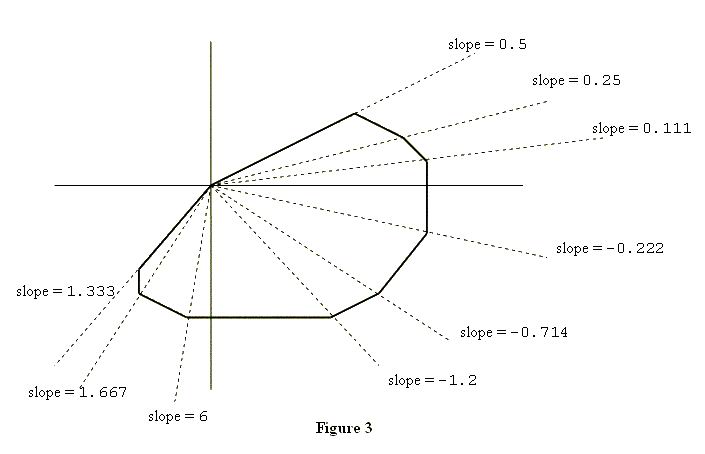计算几何:极角排序(poj 2007 Scrambled Polygon)与简单凸包(poj 1113 Wall)
来源:互联网 发布:七天网络网页版 编辑:程序博客网 时间:2024/05/27 08:13
ps:好久没来写博客了..准备重新开始了、两道简单题
poj 2007:http://poj.org/problem?id=2007
按照(0,0)逆时针排序,由于在-180 ~ 180之内,直接叉积极角排序即可

/*将p[1]到p[m-1]的点根据p[0]按逆时针方向输出排序*/#include <iostream>#include <algorithm>#include <cstdio>#define MAXN 60using namespace std;struct point{ int x,y;}p[MAXN];int cross(int x1,int y1,int x2,int y2){ return x2*y1 - x1*y2;}bool cmp(const point &a,const point &b){ int x1 = a.x - p[0].x,y1 = a.y - p[0].y; int x2 = b.x - p[0].x,y2 = b.y - p[0].y; return cross(x1,y1,x2,y2) < 0;}int main(){ int m =0; while(~scanf("%d%d",&p[m].x,&p[m].y)) m++; sort(p+1,p+m,cmp); for(int i = 0;i<m;i++) printf("(%d,%d)\n",p[i].x,p[i].y); return 0;}接下来一道凸包:
poj 1113 http://poj.org/problem?id=1113
求一个多边形距离为L的周长,一开始以为是求凸包然后等比例放大,后来一想每个顶点用一点园周即可,整个图形合起来就是凸包的周长加一个半径为L的圆的周长
#include <iostream>#include <algorithm>#include <cstdio>#include <cmath>#include <stack>#define PI acos(-1)#define MAXN 1000+10using namespace std;int N,L;struct point{ int x,y;}p[MAXN];int cross(int x1,int y1,int x2,int y2){ return x2*y1 - x1*y2;}double dis(const point &a,const point &b){ return sqrt((a.x - b.x)*(a.x - b.x) + (a.y - b.y) * (a.y - b.y));}double dis(int x1,int y1,int x2,int y2){ return sqrt((x1 - x2)*(x1 - x2) + (y1 - y2) * (y1 - y2));}bool cmp(const point &a,const point &b){ int x1 = a.x - p[0].x,y1 = a.y - p[0].y; int x2 = b.x - p[0].x,y2 = b.y - p[0].y; if(cross(x1,y1,x2,y2) != 0) return cross(x1,y1,x2,y2) < 0; else return dis(a,p[0]) < dis(b,p[0]);}bool ok(point p1,point p2,point p3){ int x1 = p2.x - p1.x; int y1 = p2.y - p1.y; int x2 = p3.x - p2.x; int y2 = p3.y - p2.y; int c = cross(x1,y1,x2,y2); if(c <= 0) return true; else return false;}//凸包扫描算法void GrahamScan(){ stack<point> s; s.push(p[0]);s.push(p[1]); int i = 2; while(i < N ){ point p2 = s.top();s.pop(); point p1 = s.top(); point p3 = p[i]; if(ok(p1,p2,p3)){ s.push(p2);s.push(p[i]); i++; } } s.pop(); double C = 0.0; point now = p[N-1]; while(!s.empty()){ //printf("pre (s.top):x= %d,y = %d\n",s.top().x,s.top().y); C += dis(now,s.top()); now = s.top(); s.pop(); } C += dis(p[0],p[N-1]); long long ans = (long long )((C + (2.0*L*PI))+0.5); printf("%I64d\n",ans);}int main(){ while(~scanf("%d%d",&N,&L)){ int m = 1; scanf("%d%d",&p[0].x,&p[0].y); for(int i=1;i<N;i++){ point pt; scanf("%d%d",&pt.x,&pt.y); if(pt.y < p[0].y || (pt.y == p[0].y && pt.x < p[0].x)){ p[m].x = p[0].x;p[m++].y = p[0].y; p[0].x = pt.x;p[0].y = pt.y; } else{ p[m].x = pt.x;p[m++].y = pt.y; } } sort(p+1,p+N,cmp); GrahamScan(); } return 0;}此题推荐一个不错的排序方法(水平序): http://www.tuicool.com/articles/iyqiY3Z
0 0
- 计算几何:极角排序(poj 2007 Scrambled Polygon)与简单凸包(poj 1113 Wall)
- 哈理工OJ 1305 /POJ 2007 多边形 Scrambled Polygon【计算几何】【极角排序】
- poj 2007 Scrambled Polygon(计算几何)
- POJ-2007 Scrambled Polygon(计算几何)
- POJ 2007 Scrambled Polygon(简单极角排序)
- poj 2007 Scrambled Polygon 极角排序
- POJ 2007 Scrambled Polygon(极角排序)
- POJ 2007 Scrambled Polygon 极角排序
- poj 2007 Scrambled Polygon [极角排序]
- POJ 2007 Scrambled Polygon 极角排序
- poj 2007 Scrambled Polygon 【极角排序】
- POJ 2007 Scrambled Polygon(极角排序)
- POJ 2007 Scrambled Polygon (极角排序)
- POJ 2007 Scrambled Polygon(几何)
- 【凸包 Graham法 极角排序】poj 2007 Scrambled Polygon
- poj Scrambled Polygon 2007 (凸包基础点排序)
- POJ 2007 Scrambled Polygon(凸包)
- POJ 2007 Scrambled Polygon(凸包)
- Tree Preorder, Inorder, and Postorder Iteratively Summarization
- 记PHPStudy-win10系统80端口被占用的经历
- hdu5724 博弈+SG函数+状压 多校1
- scala parse使用记录
- hdoj 1014 Divding(03背包问题)
- 计算几何:极角排序(poj 2007 Scrambled Polygon)与简单凸包(poj 1113 Wall)
- 开源
- linux device driver --- 驱动 poll 执行流程图
- 亿级Web系统搭建——单机到分布式集群
- hdu 5739 Fantasia (2016多校第二场1006)
- Java——反射
- 删除链表的中间节点和a/b处的节点
- Java 输入一个大写字母,如 F,输出 比如: 输入:F 输出: F EFE DEFED CDEFEDC BCDEFEDCB ABCDEFEDCBA
- scala包和引入


